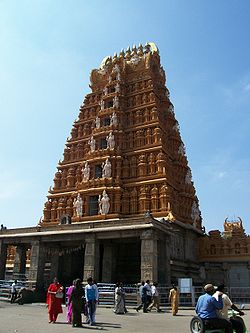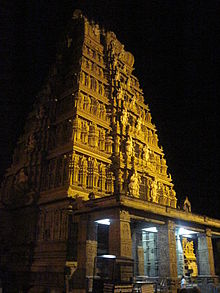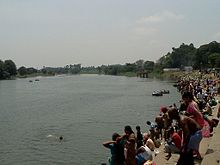- Nanjangud
-
Nanjanagoodu / ನಂಜನಗೂಡು — town — Srikanteshwara Temple at Nanjangud Coordinates 12°07′N 76°41′E / 12.12°N 76.68°ECoordinates: 12°07′N 76°41′E / 12.12°N 76.68°E Country India State Karnataka District(s) Mysooru Population 48,220 (2001[update]) Time zone IST (UTC+05:30) Area
• 656 metres (2,152 ft)
Nanjangud (Kannada ನಂಜನಗೂಡು) is a town in Mysore district in the Indian state of Karnataka. It is a temple town and is on the banks of the river Kapila (Kabini), and lies at a distance of 23 km from the city of Mysore.Nanjangud is famous for Srikanteshwara Temple. Nanjangud is also called as "Dakshina Kashi" (southern Kashi).[1]
Contents
Origin of the name
The Srikanteshwara Temple at Nanjangud is dedicated to the Hindu God Shiva, also called Sri Nanjundeshwara, "The God who drank poison" to save the earth.[1] In Hindu mythology, the Gods and demons churned the ocean in search of the ambrosia. During this churning, poison emanated first, followed by ambrosia. To prevent the poison from spreading across the universe and to destroy it, Shiva came to the rescue and drank it up. His wife Parvati then held his throat tightly to prevent the poison from spreading to the rest of his body and killing him. Narada held his mouth so that he did not vomit it out. The poison remained in his throat, making it blue in colour. For this reason, Shiva is also called Neelakantha, or "the blue-throated one". Nanjanagud literally means "the place where Nanjundeshwara resides."
History
Nanjangud has been a major Shaiva centre for nearly a thousand years. It is the biggest temple in Karnataka. The original Nanjundeshwaraa temple is said to be of Ganga period (325 - 1000 CE). This temple has then been renovated by the Hoysala kings. Both Hyder Ali and Tipu Sultan had close associations with this temple. The Wodeyar kings of Mysore made various grants to renovate the temple.
Geography
Nanjangud is located at 15°07′N 76°41′E / 15.12°N 76.68°E.[2] It has an average elevation of 657 metres (2155 ft). The taluk borders Mysore taluk of Mysore district to the north, T Narsipur taluk of Mysore district to the east, H D Kote taluk of Mysore district to the west and Gundlupet and Chamarajanagar taluks of Chamarajanagar district to the south.
WikiMapia.org Link: [1]
Getting There
By Road
From the state capital Bangalore, one can take the State Highway 17 which goes to Mysore and then onwards to Nanjangud. The total distance from Bangalore to Nanjangud is around 163 km.
Another route is about 30 km from Mysore, which takes 30 minutes by road. Interestingly, the now dilapidated bridge on the river Kabini on the highway near Sujathapuram, is said to be the oldest in India.
By Rail
Nanjangud has a railway station with broad gauge line (the standard gauge followed by Indian Railways) which runs from Mysore to Nanjangud. Mysore being an important location is well connected by rail to major cities in India and hence passengers can stop over at Mysore and take another train to reach Nanjangud. There is also a proposal to connect the Nanjagud to Nilambur Road in Kerala.It will become the shortest route between Trivandrum and Bangalore, the state capitals. Also proposed is the linking of the railway line at Chamarajanagar to the railway line at Mettupalayam in Tamil Nadu which will provide connectivity between Nanjangud and other cities in south India.
The gauge conversion of the railway track from Mysore to Chamarajanagar has been completed.By air
The nearest airport is 15 kilometers on the highway between Nanjangd and Mysore. Alternatively one can use the airports at Coimbatore International Airport or Kozhikode for reaching Nanjangud.
Places to see
Nanjundeshwara Temple
Main article: jagan Temple,NanjangudThe town is famous because of the huge temple dedicated to Lord Nanjundeswara also referred to as Srikanteswara. It is believed that sage Gauthama stayed here for some time and installed a Lingam, the idol form of Shiva. Nanjangud is also known as Dakshina Kashi or Varanasi of the South.
The temple was originally built by the Ganga rulers in the 9th century during their occupation of this region. The residing deity of the temple was later called Hakim Nanjunda; as given by the Tippu Sultan as it is said a favorite elephant of his was cured after prayer was offered to the deity. The same story is attributed to Hyder too ( as per Mysore Gazetteer)! It is said and inscribed in the temple history that his favourite and beloved elephant was bestowed with eyesight by the Lord, after Tippu Sultan's vow with the local deity. The Sultan then had a Lingam made of jade along with an emerald necklace and donated it to the temple. The Vaidya Nanjundeswara, even today is said to be a healer for his believers, and one can see even today worshippers doing Urulu seve, a ritualistic practice after taking bath in the Kapila river.
Twice every year thousands of worshippers gather for the famous Chariot Festival locally known as the Dodda Jathre and the Chikka Jathre. Idols of Lord Srikanteshwara, Goddess Parvathi, Lord Ganapathi, Lord Subramanya and Lord Chandikeshwara are kept in five separate chariots and a traditional puja is performed to the idols early in the morning on the Jathre day. After the puja chariots are flagged off. Thousands of devotees pull the Chariots carved out of wood, across the streets of the old town. The town remains immersed in festivities on the Jathre days.
The very famous Sree Srikanteshwara Suprabhata Stotram was composed by Veda Brahma. Turuvekere Subrahmanya Vishweshwara Dikshith also known as Sri. T. S. Vishweshwara Dikshith. Veda. Brahma. T. S. Vishweshwara Dikshith was born in Turuvekere, a small town in Tumkur district and was the Sanskrit professor in Maharaja Sanskrit College in the Royal Kingdom of Mysore and resided at Mysore. He was also the Aasthana Vidwan of Alankaara Shasthra of King Jayachamaraja Wodeyar Bahadur. Sri. T. S. Vishweshwara Dikshith was a learned Sanskrit scholar in several Vedas (Yajur Veda in particular) and specialised in Ghana Krama - which is the essence of the Vedas. He also composed the Sree Sharada Suprabhata and Sree Chandramoulishwara Suprabhata of Sri Sharada temple, Shringeri and Sri Chandramoulishwara temple in V. V. Mohalla, Mysore respectively. He was a Ghana Pati and had mastered several Shastras such as Alankara Shastra, Jyothishya Shastra (Astrology), Tarka, and Vyakarana (Literature) to name a few. He received several awards and accolodates from the Maharaja of Mysore, and their holiness the pointiffs' of Sringeri Sharada Peetham and Kanchi Kamakoti Peetam respectively for his contributions made to Sanskrit Literature.
Sri Raghavendra Swamy Mutt
There is the famous Sri Raghavendra Swamy Mutt which is called Preteeka Sanidhi (one can find an idol of Sri Raghavendra Swamy instead of the usual Brindavana). Also we can find the Moola Brindavanas (mortal remains) of 5 saints Sri Subodhendra teertha, Sri Sujanendra teertha, Sri Sujnanedra teertha, Sri Suprajnendra teertha and Sri Sukruteendra teertha belonging to the Raghavendra Swamy Mutt lineage known as Pancha Brindavana.Pancha Brindavana at Nanjangud
The Idol of Sri Raghavendra Swamy at Nanjangu. This is the only Idol of Raghavendra Swamy. History of Idol During 1836-61 Sri Sujnanendra Teertharu adorned the Peeta of Sri Rayara Mutt, which is Srimadaachraya's Moola paramapare. This skilled ascetic and great genius, had aspirations to attain brindavana in the proximity of Sri Rayaru at Mantralaya Kshetra. As he neared his last days, Sri Gururajaru came in his dreams and instructed "You don't need to come all the way to Mantralaya. I myself would come to you. One Brahman would fetch my idol and hand it over to you. You can consecrate that at Nanjanagudu. You will get help from Maharaja, and you will be granted a day around my own". There was a Brahman in Srirangapatna, who was suffering from multiple difficulties and had involved himself in the service of Sri Gururajaru. On an auspicious night, Rayaru came in his dreams and blessed him saying "a washerman would give my idol to you, you have to take it on foot to Nanjanagudu and hand it over to Sri Sujnanendra Teertharu who has a special affection towards me. Your difficulties would be resolved through Sujnanendra Teertharu". There was a washerman, washing clothes by beating them hard on a stone at the banks of River Kaveri at Srirangapattana. This was his usual every day work and nothing appeared to be special. But one day he observed that every beat of the cloth on the stone was producing a devine tune of 'AUM'. He then stopped using that stone to wash clothes. That same night, he witnessed Sri Rayaru in his dreams, who told him "Tomorrow a Brahman would come to you. You give him the stone, which you are using to wash the clothes. I myself am beneath it. Your days of suffering would end from tomorrow". He then disappeared.During those days, Krishnaraja Wodeyar III was the King of Mysore and he was known to be 'Rajarshi'. He had special blessings from Sri Subhodendra Teertharu and Sri Sujanendra Teertharu, pontiffs of Sri Raghavendra Teerethara Mutt. Because of them the King had a loyalty towards Madhwa Matha. He had a mrithika Brindavana of Sri Rayaru in his private space at the Palace and ensured daily pooja to the same and thus exhibiting his special devotion. One day Sri Rayaru appeared in King's dream and said "Sri Sujnanendra Teertharu is going to consecrate myself in the form of an idol at Nanjanagudu. You are to enable him for that by providing all support and get felicitated by him" . He then disappeared. All these incidents had taken place simultaneously at once. The next day, as directed by Rayaru, Brahman collected the idol from the washer man set on foot towards Nanjanagudu with utmost cleanliness and devotion and offered the same to Sri Sujnanendra Teertharu. In an auspicious time, Sri Sujnanendra Teertharu consecrated the idol of Sri Rayaru at Nanjanagud. All the help on this were offered by Mummadi Krishnaraja Wodeyar, who was blessed. The Brahman and Washer man were provided with special facilities as appropriate.
After sometime, it was the aradhane of Sri Gururajaru and a day after the uttara aradhane, Sri Sujnanendra Teertharu attained the Lotus feet of Sri Hari. His poorva aradhane coincides with uttara aradhane of Sri Rayaru. Since Rayaru knew this beforehand, as promised, he came to Nanjanagudu and stayed along with Sri Sujnanendra Teertharu and blessed him by sharing the aradhane days with himself.
Parashurama Kshetra
Near Nanjangud is the sangam, where the Kapila and Kaundinya rivers meet. This place is termed as Parashurama Kshetra which is where the sage Parashurama is said to have cleansed himself from the sin of beheading his mother.
It is said that Parashurama got immense peace of mind at this place which he did not get anywhere else. So he decided to make a penance at the place where Nanjundeshwara temple presently exists. At that time, only Adi Keshava Temple existed (which is now by the side of main-shrine). While cleaning up the place with his axe, he accidentally hit the head of Lord Shiva, who was performing penance underground. Blood started flowing and Parushurama was frightened to have committed another sin. Then Lord Shiva consoled him not to worry and build a temple of his, adjacent to Adi Keshava's. Lord Shiva also told Parashurama to perform penance at Nanjangud. Parashurama performed at the place where his temple presently is located. Lord Shiva was then immensely happy with it and gave blessings that those who visit Nanjangud should definitely visit Parashurama temple to complete their piligrimage effectively and fruitfully. [3]
Other attractions
Scenic places within a 50 km radius of Nanjangud include Eproo Waterfalls, Bandipur National Park, Shivsamudram, Shrirangapattanam (capital of Tippu Sultan kingdom), and Kabini Reservoir.
Ayurveda
Nanjangud is famous for the Ayurveda medicines manufactured by the Late Sri. B.V.Pandit. The Sadvaidyashala established by him serves people very successfully. Ayurvedic medicines produced here are marketed all over India. In earlier times (1950–70) a tooth powder brand made locally called 'Nanjangud Hallupudi' was also very famous all over Karnataka.
Economy
Nanjangud is a home to many industries which are mainly located in the Nanjangud Industrial Area which is spread across 532 acres (2.15 km2). It all started with the now closed Sujatha Textile Mills (STM) which at its peak used to employ about 3000 people. Since then, STM has closed down. However, there are other industries which thrived. There are 36 major industries, 12 medium industries and 35 small-scale units at Nanjangud. According to NIA, Nanjangud is the second highest tax-paying (sales tax of over Rs400 crore a year) taluk in the State after Bangalore. Some of the major businesses located in Nanjangud are:
Nestle India Ltd
AT&S India Pvt Ltd.
TVS Motor Company
Bannari Amman Sugars Ltd
South India Paper Mills
S Kumars
Reid & Taylor
Raman Boards
Jubilant Life sciences limited
Brakes (India)
Bacardi RUM, Gemini Distilleries Pvt Ltd
Zenith Textiles
Kottakal Arya Vaidyasala
ITC (Tobacco Processing)Bananas
A popular variety of banana locally known as Nanjangud Rasabaley has also made Nanjangud famous all over the region.
References
Categories:- Cities and towns in Mysore district
Wikimedia Foundation. 2010.








